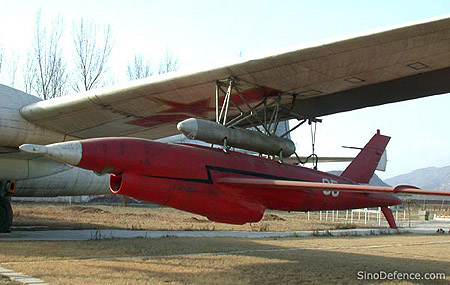| WuZhen-5 Unmanned Reconnaissance Aerial Vehicle
中国无侦-5型无人侦察机 Date:2010-02-21 Source:internet By:globalmil Viewed: |

The WuZhen-5 (WZ-5, also known as ChangHong-1) jet-powered unmanned reconnaissance aerial vehicle (URAV) was developed by Beijing Institute of Aeronautics (now Beijing University of Aeronautics & Astronautics, BUAA) based on the U.S. AQM-34N Firebee, but its ground control equipment is a Chinese indigenous design. The WZ-5 is China’s first operational URAV and entered service with the PLAAF in 1981. The improved variant WZ-5A was introduced in 1999. BUAA is currently developing a new model as the WZ-5's successor.
无侦(WuZhen)-5(WZ-5,也即是长虹(ChangHong)-1)喷气式无人侦察机(URAV)由北京航空学院(现在北京航空航天大学,BUAA)基于美国AQM-34N型“火蜂”(Firebee)发展,但是它的地面控制设备是中国本国设计。WZ-5是中国第一种可操作的URAV并在1981年进入PLAAF服役。改良型WZ-5A在1999年推出。BUAA现在正在发展一种新的型号当作WZ-5的替代者。
The PLA shot down several AQM-34N Firebee URAV operated by the U.S. Strategic Air Command during their missions over China mainland and North Vietnam in the 1960s. At least one Firebee was recovered by the PLA in relatively good conditions. The UAV was later carefully inspected by the Chinese engineers for possible reverse-engineering. In 1969 Beijing Institute of Aeronautics (now BUAA) took the lead to develop an indigenous optical-camera URAV based on the AQM-34N. The development programme consisted of three primary sub-systems: UAV airframe, WP-11 turbojet engine, and the ground control equipment.
在1960年PLA在中国大陆和越南北部上空击落被美国操作正在执行它们任务的几架AQM-34N“火蜂”URAV。至少一架“火蜂”在相对完好情况下被PLA找回。UAV后来被中国工程师仔细检查用于可能存在的逆向-工程。1969年在北京航空学院(现在BUAA)带领下发展基于AQM-34N型的本国光学-相机URAV。发展计划由三个主要的子系统所组成:UAV机身、WP-11涡轮喷气发动机和地面控制设备。
Beijing Institute of Aeronautics (BIA) used parts recovered from the Firebee wreckages to assemble two prototypes for flight tests in 1972 and these flew successfully. An additional two prototypes using Chinese-made parts made their first flight successfully in 1976. BIA also set up a UAV design and research centre responsible for the development and manufacturing of the URAV. The Chinese-made Firebee known as WZ-5 passed its design certification test in 1978 and the URAV entered PLAAF service in 1981.
1972年北京航空学院(BIA)使用从坠毁“火蜂”回收的部件组装了两架原型用于飞行测试并成功飞行。另外两架原型使用中国制造的部件在1976年成功进行了首次飞行。北京航空学院也建立一个UAV设计和研究中心负责发展和制造URAV。中国制造的“火蜂” 即是WZ-5在1978年通过了它的设计鉴定测试,而且URAV在1981年进入PLAAF服役。
The WZ-5 was reported to have taken part in the China-Vietnam border conflict in the 1980s and played an important role in collecting valuable military intelligence. A total of nine examples were built. BUAA began to develop an improved variant possibly known as WZ-5A in 1995 and the URAV made its first flight in 1999. The WZ-5A is fitted with a combined inertial and GPS navigation system for improved accuracy.
WZ-5在1980年参加中国-越南边境冲突并在收集有价值的军事情报方面扮演重要角色。总数九架样机被制造。在1995年BUAA开始发展一种改良型可能即是WZ-5A并且URAV在1999年作了它的首次飞行。WZ-5A配备有一套组合惯性和GPS导航系统用于提高精度。
The WZ-5 has mid-mounted, swept-back wings with angular tips. The engine is a bulging jet on the belly with an oval air intake and round exhaust. The fuselage is round and tapered front and rear with a pointed nose and tail cone and a belly fin. The tail flats are high-mounted, swept-back with a swept-back and tapered fin. The WZ-5 was originally carried by the modified Tu-4 Bull bomber, and later by the Shaanxi Aircraft Company Y-8E (An-12 Cub copy) turboprop transport.
WZ-5采用中-置、后掠机翼。发动机在腹部凸起采用一个椭圆形进气口和圆形排气口。圆形机身和锥形前部和尾部采用一个尖形前鼻和尾锥和一个腹鳍。后掠上置尾垂翼连同一个后掠锥形尾平翼。WZ-5最初被经过修改的Tu-4“公牛”轰炸机携带,稍后被陕西(Shaanxi)飞机公司Y-8E(An-12“幼狐”仿造型)涡轮螺旋桨运输机。
During its mission, the WZ-5 UAV is first carried by its carrier aircraft to the target zone, and then released at the altitude between 4,000 and 5,000m. The UAV then automatically climb to its operational altitude of 17,500m. Once entering the target zone, the UAV flies under the autopilot, which is pre-programmed with flight parameters such as altitude, path, speed, duration and range. After completing its mission, the UAV returns to the recovering zone, and then was recovered by parachute under remote control.
在它的任务期间,WZ-5 UAV被它的运载飞机首先携带到目标地域,然后在4,000和5,000米高度释放。UAV然后自动爬升到17,500米操作高度。一但进入目标地域,UAV飞行在自动驾驶仪控制下飞行,预-编程飞行参数,像是高度、路径、速度、续飞时间和航程。在完成它的任务之后,UAV返回到回收区域,然后在遥控下采用降落伞回收。
The WZ-5 is fairly obsolete comparing to the modern Western-designed URAVs. It can only operate in day light period, and does not have the real-time datalink to transmit the imagery information to the ground. In addition, the WZ-5 can only fly according to the pre-programmed flight parameters, and cannot adjust its speed, altitude, and path according to the change of enemy air defence and weather. The ground control does not have any real-time control over the UAV.
WZ-5与现代西方设计的URAV相比是过时的。它只能在白天光照期操作,而且没有实时数据链传送图像数据到地面。除此之外,WZ-5仅仅依照预-编程飞行参数飞行,而且不能够依照敌人防空和天气变化调整它速度、高度和路径。地面控制不能实时控制空中的UAV。
The fuselage of the WZ-5 consists of six sections: the radar compartment, the camera compartment, the fuel tank, the engine compartment, the avionics compartment, and the parachute compartment. The UAV has five camera windows, and is fitted with day-light and infrared cameras for imagery intelligence (IMINT) missions. The aerial photos are stored on the films carried inside the UAV fuselage.
WZ-5的机身由六个部件所组成:雷达舱、照相机舱、燃料箱、发动机舱、航空电子舱和降落伞舱。UAV有五扇照相机窗口,而且配备有昼-光和红外照相机用于图像情报(IMINT)任务。空中照相储存在胶片上在UAV机身内携带。
The WZ-5 is powered by a WP-11 turbojet, rated at 8.33kN dry.
WZ-5由一台WP-11型涡喷发动机提供动力,额定8.33kN净推力。
Specifications
Dimentions: Wingspan 9.76m; Length 8.97m; Height 2.18m
Weight: Empty 1,060kg; Maximum take-off 1,700kg; Mission equipment 65kg; Fuel 620kg
Speed: Max 800km/h (at 17,500m altitude)
Range: 2,500km
Flight Endurance: 3 hous
Service Ceiling: 17,500m
规格
外形尺寸:翼展 9.76 米;机长 8.97 米;机高 2.18 米
重量: 空重 1,060 公斤;最大起飞重量 1,700 公斤;任务设备 65 公斤;燃料 620 公斤
速度: 最大 800 公里/小时(在 17,500 米高度)
航程: 2,500 公里
续飞时间: 3 小时
升限: 17,500 米
Last update: 25 March 2007
最后更新:2007年3月25日
上一篇:Harpy Unmanned Aerial Vehicle 下一篇:ChangKong-1 Unmanned Aerial Vehicle / Target Drone
| Sea Cavalry SD-40 Maritime UAV
中国海上骑兵SD-40海上无人机 |
| Sea Cavalry SD-40 is a vertical take-off and landing (VTOL) unmanned aerial vehicle (UAV) designed and manufactured by Chinese manufacturer Xiamen Hanfeiying Aviation Technologies.... [2023-05-25] |
| Harbin BZK-005
中国哈尔滨BZK-005型高空长航时无人机 |
| The BZK-005 high-altitude, long-range UAV is a reconnaissance aircraft designed by Beijing University of Aeronautics & Astronautics and Harbin Aircraft Industry (Group) Co., Ltd.... [2017-06-25] |
| Wing Loong Unmanned Aerial Vehicle (UAV), China
中国翼龙(Wing Loong)无人机 |
| Wing Loong (Yilong / Pterodactyl) is a medium-altitude, long-endurance (MALE), unmanned aerial vehicle (UAV) developed by Chengdu Aircraft Design & Research Institute (CADI), a division of the Aviation Industry Corporation of China (AVIC).... [2016-02-18] |
| Xianglong Unmanned Reconnaissance Aerial Vehicle
中国“翔龙”无人侦察机 |
| During the Air Show China 2006, the Chengdu Aircraft Corporation (CAC) unveiled the model of its “Xianglong” unmanned aerial vehicle (UAV) concept. The UAV appeared to be a high-altitude, long-duration UAV for strategic reconnaissance ro... [2010-02-22] |
